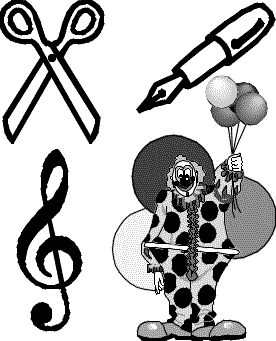|
OCEAN COUNTY ACADEMY OF THE ARTS • GRAPHIC DESIGN TECHNOLOGY PROGRAM |
|
All artwork that is going to be printed by any
printing process is artwork for reproduction. Believe me...that is a lot of artwork. Think
about it, for every burger sold in the USA, someone had to design the wrapper it is sold
in. Someone designed every package, sign, advertisement, magazine, newspaper, package,
computer game artwork...the list is practically endless!!!
The artwork that you will produce must be "photo-converted". Simply put, that
means that someone (sometimes you) will be using a special kind
of camera to take a picture of your artwork or outputting your work to a special computer
printer called an imagesetter. That picture of your layout or design will usually be
on negative film. That negative is then used to produce a plate for a printing
press.
In order to get started, you must first understand that there are
two basic types of artwork:
The first type of artwork for
reproduction is called "line art" or "line copy". "Line
copy" is artwork or type that consists of just black and white.
It is usually black ink on white paper. However, sometimes line copy looks like it has
gray tones in it. If you were able to magnify the gray tones, you would be able to see
that they are not really gray. The tones consist of small black dots that create the
"illusion" of gray. ( CLICK HERE
TO VIEW ILLUSTRATION ) Line copy may be created by hand using traditional
art or drafting tools. It also can be typed words that we refer
to as "typeset copy". Typeset copy is usually produced by a computer and printed
out.
Sometimes line copy is still created by drawn images or letters, such as calligraphy. ( CLICK HERE TO VIEW ILLUSTRATION )
The second type of artwork is referred to as "continuous tone copy". "Continuous tone copy" is artwork that contains colors in it or
consists of a photograph (black and white photos or color photos,
it doesn't matter). ( CLICK HERE
TO VIEW ILLUSTRATION ) This kind of artwork is not as easy to copy. If we
were to take a photograph and place it on a copier, the copy we would get of it wouldn't
be so good. In order to copy or print copies of "continuous tone copy", we have
to change it into just black and white, so that it will copy easier.
Line copy is the easiest "copy" to make copies of. If we were to take most line
copy and just throw it on a copier, we would get good quality copies. Therefore, all copy
that we want to make copies of, MUST be "line copy" or
"converted" into line copy.
When we convert the continuous tone copy into line copy, it will consist of tiny black
dots, just like some line copy. We call this converted copy a "halftone". It is
done by scanning the photo onto the computer and converting it using special software.
Otherwise, it may be converted by using a special "line screen" on a large
camera. It copies well, because a "halftone" consists of
only black dots on a white background. We call this an "illusion" of gray. (
CLICK HERE TO VIEW ILLUSTRATION )
Well...that does it for
this concept. Hopefully you can understand this information. It may sound simple, but is
very important for all visual artists and graphic designers to understand.
Go Back to the Art for Reproduction Menu Page
LINE ART or LINE COPY

Here are some examples of line copy. Notice that there is only black and white.
The "grays" that you see are really just black dots.
TYPESET COPY

Typeset copy is usually produced on a computer. Letters or type are also considered
"line copy".
NORMAL (MAYBE ABNORMAL!!) B&W PHOTO

A normal black and white photograph will look okay on the web or in someone's wallet, but it will not copy or reproduce well. In order to reproduce, it must be converted into a "halftone".
This is how the same photo would look if converted to a halftone and then enlarged. Notice
that there are no longer any grays. The photo now consists only of dots. If it were
reduced much smaller, we would hardly notice the dots.